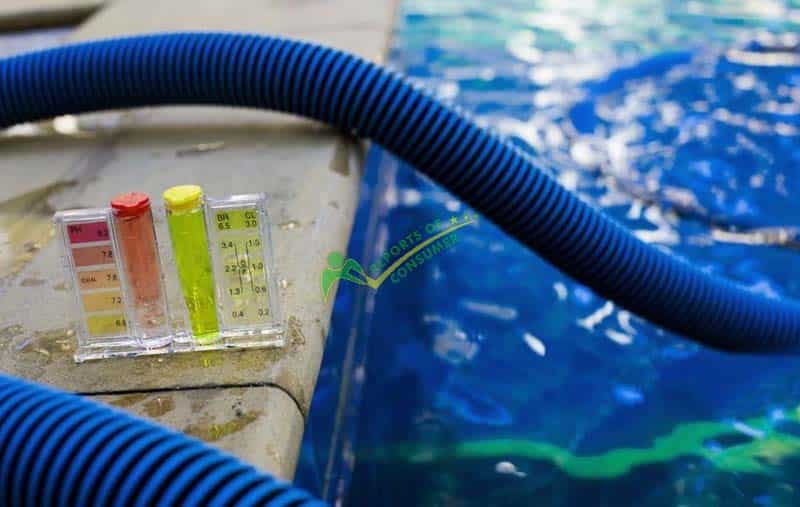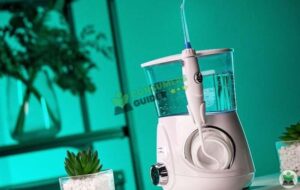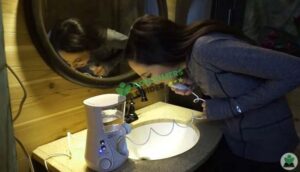In the previous article, we deeply explained how higher levels of pH and alkalinity affects the pool water, equipment and health of the users. Same goes for the low levels of pH and alkalinity.
If you are noticing your vinyl liners are getting brittle, burning eyes and dry skin while swimming or corrosion of metals (if the equipment is made up of metal; ladder etc.), then your pH and alkalinity levels are very low.
In this article, we will guide you on how to raise the pH and alkalinity in a pool to have the controlled water chemistry of the pool.
So, let’s dive in.
Signs of Low pH in a Pool
If you are new to using pools (either in-ground Pools or above ground pools) and learning about the pool maintenance, then you must know the signs of low pH and alkalinity in your pool.
- Etching and deterioration of concrete, plastic, stone and tiling walls.
- If your skin is getting dried after every swim.
- The pool covers and floating materials are damaged.
- The plastic fittings of the pool and pool liner become brittle.
- The chlorine will dissipate faster than usual.

Cause of Low pH in Pool
The most common cause which we have been observing for years now is due to usage of large amounts of chlorine tablets or using the chlorine in the Pool very frequently.
The chlorine tablets although helps to clean the water of Pool but the pH of these tablets are around 2.8 to 3, which on extensive and frequent usage can disrupt the pool chemistry.
Also, rain is the other main cause of decreasing the pH of the pool as the rain has 5 pH. It is recommended to cover your pool with the pool cover to avoid such things.
Relation Between pH and Alkalinity of a Pool
Although we have described in detail the relation between these two but if you are new here, then here is the brief explanation of it.
In simple terms, pH defines the acidic and basic nature of the water or any product whereas the alkalinity (buffer) of the water informs you about “the ability to resist the pH change”.
Also, the lower the alkalinity of the water, the lower the pH and higher the acidity. To elaborate it more, higher the alkalinity of water, the higher the pH and vice versa.
That’s why pH reducers and increasers can reduce and increase the pH and alkalinity levels respectively.

Alkalinity is measured in ppm (parts per million) and the recommended value is 80ppm to 120ppm. If the alkalinity level is below 80ppm, then you need to boost it up.
In case, if you want to read in more detail about this and about lowering the pH and Alkalinity in your pool, make sure to check this article.
Methods to Raise pH and Alkalinity in a Pool
After you have tested the pool water with a pH pool kit and came to know the pH and alkalinity levels are low, then you need to raise them in order to maintain your pool chemistry.
However, there is digital equipment available in the market as well which gives you the immediate readings. Opt for any method as per your convenience.
So, the easiest methods to increase the pH and alkalinity level of the pool are described below which we have personally tested and applied.
1. Baking soda (Sodium bicarbonate)
Baking soda is also known as the alkalinity increaser in the market as it contains bicarbonate in it. Usage of baking soda is being highly preferred as it is easily available and doesn’t cost you a fortune.
Before adding the baking soda, keep the record of initial pH level to compare it with the final one after adding the baking soda. Also, the recommended pH of the pool should be around 7.4 to 7.8.

For your information, Sodium bicarbonate is the only chemical which can raise the alkalinity and pH level efficiently as compared to other chemicals. To add it in the pool, follow these instructions;
- Check the TA (total alkalinity of your pool) and pH at least 3 times to be sure about your pool water concentration.
IMPORTANT NOTE: The quantity of baking soda varies from pool size and the acidity level. For example, if the pH level is 2 then a small quantity of baking soda isn’t going to work. So, for that, you must consult your pool instruction manual or the supplier to know about the adequate quantity.
- If your target is to increase the alkalinity level only, then use baking soda. The amount depends upon the pool size and the alkalinity level. On an average, adding 1 ounce of baking soda in 1000 gallons of water can increase the pH level by 0.1.
- Dilute the baking soda (it would be written in the instruction manual as well) to enhance the efficiency. And, every container or packet of baking soda comes with the proper instructions of how to dilute it.
- Now pour the diluted solution in the water. Baking soda is soluble in the water so it will take less time to get dissolved. Furthermore, start the water pump to mix it well in the pool.
- Let the solution rest for at least 6 hours and then check the new readings. Your pool pH and alkalinity levels would be balanced after that.

How much baking soda is needed to raise the pH?
As per our tests and experiences, 2.5 pounds of baking soda for 10,000 gallons of water increases the alkalinity level by 10ppm and will increase the pH to 7.8 if it is less than 7.4. However, when you start adding the chemical in the water, do not add the whole amount directly.
Moreover, to balance the pool water’s quality as well, it would be best to add only one-fourth of the recommended value. (1.25 pounds for 10,000 gallons of water).
The best time to add baking soda in the pool
In order to get the most efficient results, it would be best to add the baking soda or chemical at the evening or night time. Because, in day time, the UV radiations can react with the baking soda and the whole reaction and efficiency would underperform.
Side note: If you are planning to install an above ground pool, you can check this easy to follow -Installation steps guide.
2. Soda Ash
Soda ash is also known as the pH increaser as it contains carbonates which increases the pH level of the water.
If your pH level is too low (around 5-6) and alkalinity level is around 70ppm, then it would be best to add soda ash (Sodium Carbonate).

On an average, two pounds of soda ash (32 ounces) is recommended to raise pH levels for 10,000 gallons of pool water.
For the over ground pool, people also go for draining the entire pool but one can adjust the levels without draining as well.
Recommended: Above Ground Pool Installation Guide
3. Aeration method
The other alternative method is to aerate the pool which one can perform naturally or by adding Muriatic acid. Let us discuss both methods and which one is best for who.
Mostly the pool comes with the aerators which throws a stream of Oxygenated water (by exposing the water to the Oxygen) into the pool which then infuses with the pool air and releases dissolved gasses in the water, mainly Carbon dioxide.
The Carbon dioxide release or outgasses increase the pH levels. This process takes some time to lower the pH and after the Carbon dioxide outgases, check the pH and TA levels. If both of them rise and cross the permissible limit, then add some acid to balance them.

It is recommended to aerate the pool for at least two hours in order to increase the pH from 6 to 6.6. Aerate the pool as per the acidity level of your pool. If it is highly acidic, then aerate it for a longer time.
Can you use Bleach in a Pool?
A lot of people asked us about using the bleach in the pool instead of chlorine. Well, let us inform you that bleach is chemically chlorine (bleaches have variable concentrations of chlorine). Pool-grade chlorines and regular-use bleaches are the same.
And to answer the question, yes! You can use a bleach in the pool in order to sanitize and clean the pool. Now you must be wondering how much quantity of bleach should be added. Right?
On an average, for 10,000 gallons of pool water, add around 150 to 200 ounces of regular bleach to sanitize and clean the pool water.
1 gallon= 128 ounces
As most of the bleach bottles are of 1 gallon size, it would be best to use 1 ½ bleach bottles and wait for 4 hours before swimming in the pool.

Quickest way to Raise the pH in a Pool (The best method)
In our opinion and according to our testing, the most safe and best method to raise the alkalinity and pH level is using the Baking soda (alkalinity increase). It is a natural alkali with an 8 pH. So, using Baking soda would be the best option.
You may also like: Ways to find and fix leaks in a Pool
FAQs
Is it safe to have low or high alkalinity and pH levels in the pool?
In either case, it is dangerous for the pool quality. If the pH and alkalinity levels are too low (acidic), then the materials of the pool will get corroded (especially metal ones).
And, if the pH and alkalinity levels are too high (basic), the pool water will get cloudy, scaling on the surface and the water will get prone to algae growth.
So, for both cases, it is recommended to maintain the pool water chemistry. As well as, before you winterize your above ground pool, to check for pH and Alkalinity is very important.
What is the right way to add chemicals in the pool?
The best and appropriate way to add any chemical in the pool is to turn Off the water pump and add the chemical (diluted or powder as per the instructions on the chemical itself) in the center of the pool.
Now start the water pump to mix the chemical thoroughly and quite efficiently.

What is the pool balance and why is it important?
If your pool water is too acidic or too basic, it is not good for swimming. Both extreme levels have their own consequences and having balanced pH (7.4 to 7.8) and alkalinity levels (80 ppm to 1200 ppm, where 100 ppm is ideal) maintains the pool water quality.
When the water is balanced, all the water components of the pool are in the safety limits which further prevents the pool and pool equipment from getting damaged.
Wrapping Up
To pen off, if you are noticing corrosion and etching of pool walls and liners, then your pH and alkalinity levels are too low (acidic). If your pH level is too low as compared to alkalinity level, then go for soda ash and if it is vice versa, then go for baking soda.
However, baking soda is the natural alkali with the pH of 8 and it influences both; alkalinity and pH level that’s why we would recommend this option. Furthermore, it is important to balance both levels for the sake of pool quality.
Also, keep you pool clean as much as possible.
And, if you are having any second thoughts regarding raising the alkalinity and pH of the pool water, then feel free to share with us







